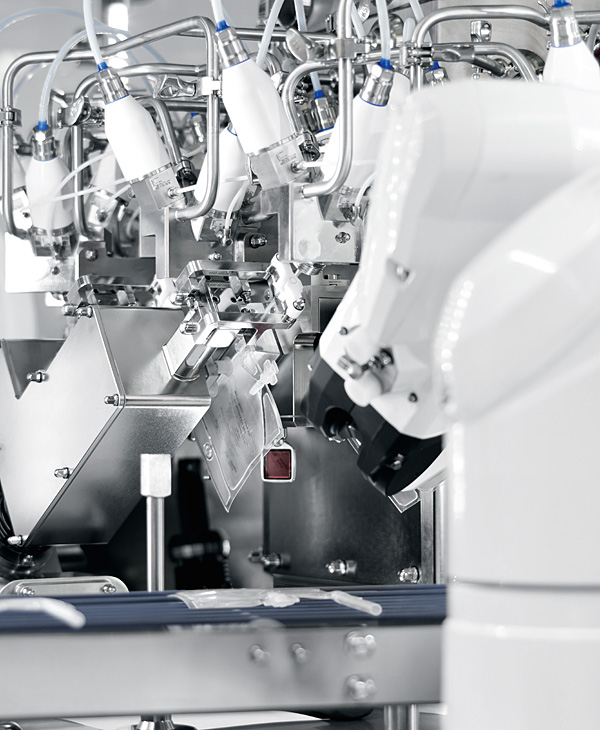It’s hard to imagine a doctor’s office or clinic anywhere in the world without infusion bags. As with any product administered intravenously, the need to minimize patient risks means that quality requirements for the bag content are especially high. Frequently, after being filled with liquid, infusion bags are terminally sterilized to ensure the vitally important sterility. However, this method is not suitable for active ingredients that are sensitive to heat or gamma radiation, as is the case with the products of the Hong Kong biotechnology company New β Innovation.
“The line takes every necessary hygiene and safety guideline into account.” Christian Kollecker, Director Aseptic Technology at Harro Höfliger
That’s why Harro Höfliger went in a different direction with its first aseptic filling and sealing machine for IV bags. Our experts focused on completely sterile processes and an active open restricted access barrier system (RABS).In the sterile conditions of the line (EU/GMP Cleanroom Grade A/ISO 5), New β Innovation manufactures IV products at a mid-scale level in its Canadian facility.
“We specialize in veterinary products that are used around the world, and which we fill and seal at up to ten bags per minute,” says Endre Szilagyi, Senior Manager, Production from New β Innovation. “Of course, the machine can also be used for filling oxygen-sensitive IV products for human use,” notes Christian Kollecker, Director Aseptic Technology at Harro Höfliger. “The line takes every necessary hygiene and safety guideline into account. It is suitable for bags with fill volumes of 20 to 250 milliliters, and is a particularly good fit for the ‘low volume-high margin’ sector.”

1. Glove ports ensure hygienic separation between operator and process.
2. After opening the outer bag, the inner bags are disinfected. They dry on a stainless steel rack.
3. The infusion bags are placed individually on the transfer belt and are automatically fed to the rotary platform via a “mousehole”.
4. A robot which is specially designed for aseptic production environments connects the bags to the filling system.
5. At ten stations the bags are flushed with nitrogen, emptied, filled with the product and sealed.
6. A further robot arm removes the IV bags and separates good and bad parts.
“One-time docking”: a global first

The filling tube and the filling nozzle remain connected until the IV bags are transfered from the machine. This one-time docking principle minimizes the risk of particle entry.
The machine is loaded manually. “The no-touch method proved itself to be the best solution for the continuous transfer of our flexible bags, which can easily stick together,” says Endre Szilagyi. Operators use glove ports to open the pre-sterilized, bagged components, as well as to separate them. A camera records the position of the bag on the transfer belt so that the Stäubli Stericlean robotic arms can precisely place the IV bags on the rotary platform and connect the filling tube to the aseptic triple filling head.
The special feature is that the connection to the filling nozzle remains in place through all of the following gas purging, evacuation and filling processes until the transfer from the machine. Harro Höfliger uses this one-time docking principle to minimize the risk of particle entry and keep the residual oxygen content in the bag low.
The amount of nitrogen flushing and the subsequent evacuation of the bag using vacuum can be flexibly adjusted. An integrated, laser-based Wilco HSA (head space analysis) module provides an in-line measurement of the oxygen content, making the quality control results available immediately. If the residual oxygen level is over one percent, the bag is removed and not filled. A high-precision measurement of mass flow using the Coriolis effect is performed by a sensor, which ensures that each infusion bag has been filled to exactly the right amount. An aseptic rotary distribution is used to supply all fill media in a sterile manner.
Learn more about “One time docking” in the video:
The video gives you a panoramic view of the semi-automatic line:
Quality down to the very last detail
In the next step, paddles “massage” the filled bags so that any trapped gas from the infusion solution rise upwards to the filling tube. The opening is tightly sealed by radio frequency welding to minimize the heat transfer to the active substance. Then, the filling tube is cut off and removed.
An important component of quality-oriented production is perfect cleaning after each batch using an integrated CIP/SIP (cleaning in place/sterilization in place) system. “The machine’s hygienic design meets the highest pharmaceutical standards,” explains Christian Kollecker. “The complete pipeline system is connected to an automatic CIP/SIP system, making disassembly unnecessary for cleaning. Furthermore, the entire line is optimized for decontamination using hydrogen peroxide based dry fog.”
“The filling system is one of a kind, only the team at Harro Höfliger can make it happen.” Benjamin Wai, Director of New B Innovation Limited
Benjamin Wai, Director of New β Innovation, is very satisfied with the filling machine – a second line for the Chinese production facility was ordered quickly. “When we first contacted Harro Höfliger, we were looking for laboratory equipment for aseptic liquid filling,” says Benjamin Wai. “Because the processes have worked perfectly, Harro Höfliger has scaled from tabletop devices to the semi-automatic production line. In close coordination, we have jointly developed a compact machine layout that meets all of our requirements and takes into consideration the spatial conditions in the cleanroom of our production facility down to the smallest detail.”
Infusionsbeutel
About New β Innovation 
New B Innovation Limited, established in 2007, is a dedicated player in the global medical biotechnology market. With headquarters in Hong Kong, the company employs the latest technologies and innovative approaches to deliver health care products that bring better quality of life and address unmet medical needs.
Download this article as PDF file
Photos: Helmar Lünig, New β Innovation, stock.adobe.com/Sherry Young

